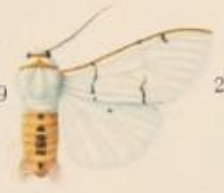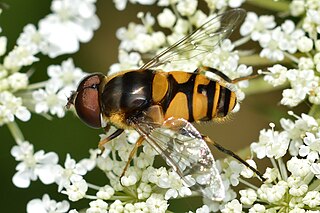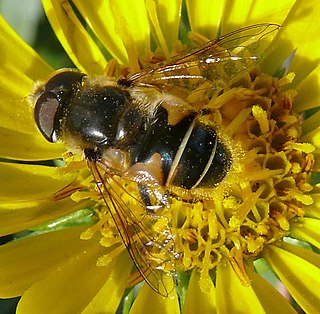
Darkling beetle is the common name for members of the beetle family Tenebrionidae. The number of species in the Tenebrionidae is estimated at more than 20,000 and the family is cosmopolitan in distribution.
The arthropod leg is a form of jointed appendage of arthropods, usually used for walking. Many of the terms used for arthropod leg segments are of Latin origin, and may be confused with terms for bones: coxa, trochanter, femur, tibia, tarsus, ischium, metatarsus, carpus, dactylus, patella.

Cleridae are a family of beetles of the superfamily Cleroidea. They are commonly known as checkered beetles. The family Cleridae has a worldwide distribution, and a variety of habitats and feeding preferences.

Platypezidae is a family of true flies of the superfamily Platypezoidea. The more than 250 species are found worldwide primarily in woodland habitats. A common name is flat-footed flies, but this is also used for the closely related Opetiidae which were formerly included in the Platypezidae.
Vulcaniella anatolica is a moth of the family Cosmopterigidae that is endemic to Turkey.
Xyroptila peltastes is a moth of the family Pterophoridae. It is found in Australia.

Deuterocopus atrapex is a moth of the family Pterophoridae described by Thomas Bainbrigge Fletcher in 1909. It has been recorded from Sri Lanka, Assam, Selangor, the Tenasserim Hills, south-eastern Borneo, Ternate, Ambon Island, Batian, southern Sulawesi, the Sangihe Islands, Halmahera, Neu Pommern, northern New Guinea, the Kei Islands, the D'Entrecasteaux Islands and Queensland.

Trichoptilus ceramodes is a moth of the family Pterophoridae that is found in Australia, including New South Wales and South Australia.
This glossary describes the terms used in formal descriptions of spiders; where applicable these terms are used in describing other arachnids.
Caloptilia glutinella is a moth of the family Gracillariidae. It is found in Canada and the United States. The species was first described by Charles Russell Ely in 1915.

Scelophysa trimeni, commonly known as the blue monkey beetle, is a species of scarab beetles in the monkey beetle subfamily Rutelinae.

Spilosoma buryi is a moth in the family Erebidae. It was described by Walter Rothschild in 1910. It is found in Ghana and Nigeria.

Cymbiodyta bifidus is a species of hydrophilid beetle. The species was formerly the sole member of the genus Helocombus.

Brachyopa flavescens, The Yellow Sapeater, is a fairly common species of syrphid fly. It has been observed in northeastern North America. Hoverflies get their names from the ability to remain nearly motionless while in flight. The adults are also known as flower flies for they are commonly found around and on flowers, from which they get both energy-giving nectar and protein-rich pollen. Larvae for this genus are of the rat-tailed type. B.flavescens larvae have not been described.

Eristalis transversa, the transverse banded drone fly, is a common species of syrphid fly first officially described by Wiedemann in 1830. Hoverflies get their names from the ability to remain nearly motionless while in flight. The adults are also known as flower flies for they are commonly found around and on flowers, from which they get both energy-giving nectar and protein-rich pollen. The larvae are rat-tailed type but larvae of this specific species has not been reported.

Blera badia, the Common Wood Fly, is a common species of syrphid fly first officially described by Walker in 1849. Hoverflies get their names from the ability to remain nearly motionless while in flight. The adults are also known as flower flies, for they are commonly found around and on flowers, from which they get both energy-giving nectar and protein-rich pollen. The larvae are of the rat-tailed type, feeding on exuding sap or in the rot holes of trees.

Eristalis hirta, the black-footed drone fly, is a common Western North American species of syrphid fly first officially described by Loew in 1866. Hoverflies get their names from the ability to remain nearly motionless while in flight. The adults are also known as flower flies for they are commonly found around and on flowers, from which they get both energy-giving nectar and protein-rich pollen. The larvae are aquatic filter-feeders of the rat-tailed type.

Helotrephidae is a family of aquatic bugs found mainly in the tropical regions with many species in the Oriental Realm and a few from Africa, Madagascar and South America. These bugs are found swimming or walking amid submerged vegetation in stagnant or slow moving, shaded freshwater in forest habitats. They are a sister group of the Pleidae.

Hermatobates is a genus of wingless marine bugs placed as the sole genus in the family Hermatobatidae that are sometimes known as coral-treaders. They are quite rare and known only from coral reefs in the Indo-Pacific region. During low tide, they move over the water surface not unlike the more familiar water-striders around coral atolls and reefs and stay submerged in reef crevices during high tide.
'Blera metcalfi , Metcalf's wood fly, is a rare species of syrphid fly first officially described by Curran in 1925 Hoverflies get their name from the ability to remain nearly motionless while in flight. The adults are also known as flower flies for they are commonly found around and on flowers from which they get both energy-giving nectar and protein rich pollen. The larvae are of the rat-tailed type feeding on exuding sap or in the rot holes of trees.














